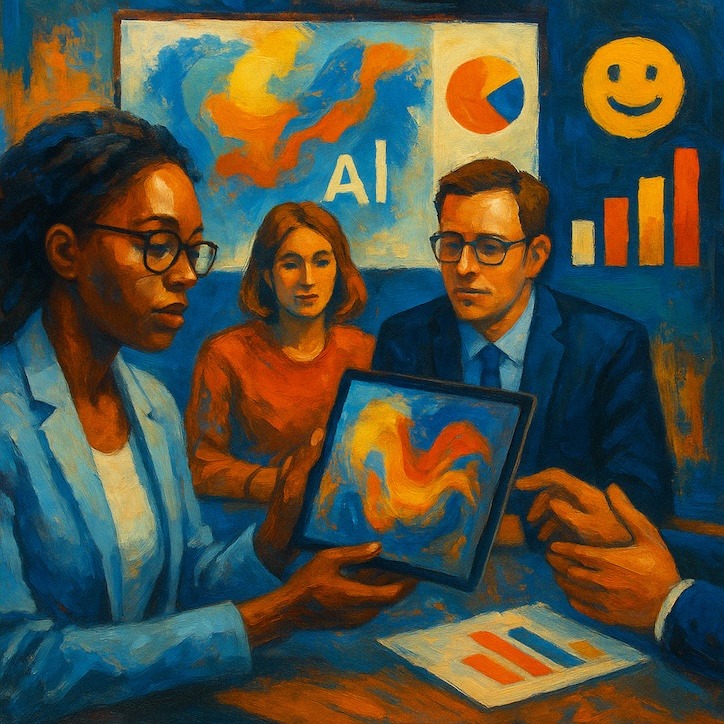Burnout doesn’t always begin with missed deadlines or plummeting productivity.
Often, it starts in quieter places—unread signals, unspoken stress, and unseen emotional shifts.
In today’s fast-paced workplace, leaders need better ways to understand how their teams are really doing. And one of the most surprising tools for that?
Artificial Intelligence.
But not the kind that invades privacy or micromanages behavior.
At Blimish, we’re using AI in a different way—to surface emotional insights that often go unnoticed, so teams can thrive with greater empathy, awareness, and trust.
? What Is Emotional Data—and Why It Matters
Most managers track output: tasks completed, KPIs hit, projects shipped.
But emotional data—how your team feels, communicates, and connects—is just as important. It reveals the early signals of burnout, disconnection, and morale dips that don’t show up in spreadsheets.
Here are a few often-overlooked emotional cues:
- ? Changes in tone and sentiment A shift toward shorter, more defensive messages could mean rising tension. AI can pick up on these patterns and flag potential issues before they escalate.
- ? Drop in interaction frequency When once-engaged teams go quiet, it’s not always workload—it may reflect disconnection, distrust, or emotional fatigue.
- ? Flat or inconsistent emotional expression Whether through body language, written tone, or energy in meetings, subtle emotional shifts can indicate that someone is struggling—even if they haven’t said it out loud.
When these small signs are ignored, burnout builds. But when they’re addressed with care, teams stay connected—and resilient.
? How Blimish Uses AI to Surface Emotional Insight
At Blimish, we’re using AI-powered tools in ways that enhance emotional intelligence—without crossing personal boundaries.
Here’s how:
1. AI Art Therapy
We invite teams to create digital artwork based on how they’re feeling in the moment.
AI then interprets the patterns, colors, and forms to uncover emotional themes—giving teams a creative, non-verbal way to express stress, engagement, or overwhelm.
No one is forced to explain. The image speaks first.
2. Anonymous, AI-Powered Surveys
Using sentiment-aware surveys, we track how emotional trends shift over time—from stress levels to feelings of connection or safety.
This creates a high-level emotional map of the team, revealing themes, not names—so employees feel safe, and leaders stay informed.
Together, these tools give a 360° view of a team’s emotional landscape: deep, data-informed, and fully anonymized.
? Why Anonymity Builds Real Trust
Let’s be honest—most people won’t open up if they fear it’ll come back to them.
That’s why anonymity is key. When employees know their feedback won’t be tied to their name, they’re more likely to express what’s real—not just what’s safe.
Trust grows. Insights deepen. And leaders can make decisions grounded in empathy, not assumption.
At Blimish, we design all of our emotional intelligence tools around this principle:
If it’s not safe to share, it won’t be honest. And if it’s not honest, it can’t help.
? Tech That Listens—Without Watching
AI isn’t here to spy. It’s here to listen—gently, respectfully, and in patterns.
When used well, AI doesn’t replace human intuition. It strengthens it.
It surfaces what’s often left unsaid, so that teams and leaders can move forward with clarity and care.
? What’s Next
In our next post, we’ll explore how leaders can respond to emotional data—not with panic or policy, but with presence, curiosity, and real cultural shifts.
And if you’re ready to discover how emotional insight could transform your team, take a look at our Corporate Wellness Intensive—a psychologist-led, AI-supported experience that goes beyond perks to build real resilience.
? Learn more at blimish.com/cwi
Stay tuned for more in our Burnout Prevention & Team Resilience series. Together, we can change the narrative and build workplaces where burnout isn’t inevitable—it’s preventable.

